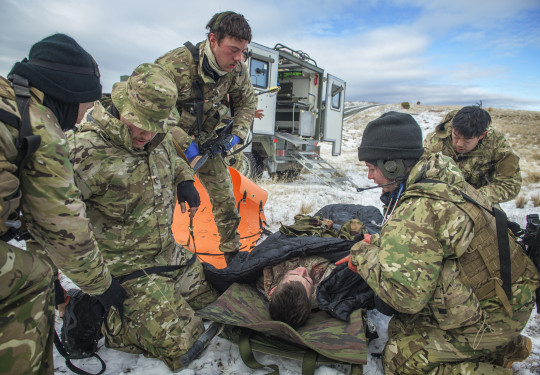Medic training through COVID-19 lockdowns
Future Navy, Army and Air Force medics need three years of study and training to qualify. Meet two members of the ‘Nealis’ class who graduated this month from Defence Health School in Christchurch.
28 November, 2023
Able Medic Assistant (AMA) Olivia Jones says initial stages of medic branch training might be heavily classroom-based, but it gets pretty hands-on later.
AMA Jones was the top student in her class of 10, who graduated at Burnham on 15 November. She also won the He Whakaatu Nui award, presented to the student who best demonstrated the attributes required of a New Zealand Defence Force medical practitioner in the specific areas of Competence, Reliability, Compassion, and Care.
The Nealis class is named for its patron Wing Commander (Rtd) Paul Nealis, former Chief Medical Officer at the Defence Health Directorate.
The school has two intakes a year, one in January and the other in June/July. The course involves a four-month period of Auckland University of Technology (AUT) study on arrival, followed by four modules completed over the remaining 32 months, including holidays.
The medics gain AUT qualifications along the way in the form of the Diploma in Paramedic Science followed by the Graduate Certificate. Medics can then move onto the degree programme and work towards the Bachelor in Health Science (Paramedicine) if they wish to, once they have posted to their new units.
AMA Jones, 21, from Tauranga, says she was inspired by her grandfather, a former Navy man who shared photos of his adventures with her. “He got paid to travel the world,” she says.
She graduated from Basic Common Training in December 2020 and came to Burnham to start her medic training.
“It was pretty challenging with Covid lockdowns,” she says. “I was in barracks and you have to keep to your ‘bubble’. It meant there was distance learning and it’s hard to do some of this online. But it went pretty well.”
The course gets hands-on with class members working with St John’s Ambulance, and the field exercises were fun, she says.
“You’re not thrown in at the deep end,” she says. “With the practical side, you get eased into it, and they slowly put more and more scenarios at you.”
The final field exercise, held in Tekapo, combines training completed throughout the four modules. The students are treated as if they were fully qualified medics, enabling them to graduate with confidence and understanding of what will be required of them on posting to their new units.
AMA Jones says being away from home for three years is tough, and after three years in Christchurch you “kind of lose the Navy vibe. But it was great to be in such a close-knit class.”
Graduating was cool, she says. “My granddad was on Facetime the whole time and my parents came down.”
She’s hoping to be deployed next year. “My Basic Common Training class that I graduated with in 2020, they’ve been everywhere and doing all sorts.”
Private Justin Zarandona and Able Medic Assistant Olivia Jones
Private Justin Zarandona, from Christchurch, has parents who are both nurses. “My Dad was pretty keen on my joining the military, he had wanted to be an officer in the Philippines. We’ve been in New Zealand 10 years. I did my Army basic training for four months at Waiouru, then came down here.”
He loved the practical side of the course. “I prefer the practical aspects of training over the academic work. But it’s hard doing practicals during COVID lockdowns and you’re on a Zoom meeting.”
The field exercise in Tekapo was great, he says. His class was dealing with a Humanitarian and Disaster Relief scenario, a Cyclone Gabrielle situation superimposed into Tekapo. It’s not a scenario where you turn up with no idea of what’s ahead. “You get informed by radio of an idea of patients there and the priority of them. The weather really turned it on for us, with a bit of snow. It was a really good experience.”
His advice to those considering the medic trade is that it is a hard course but worth it. “Just do it. The staff take care of you pretty well. And we were a very tight group, even with a bit of service rivalry and banter.”
'Nealis' class who graduated this month from Defence Health School in Christchurch.
Modules included
Military Medical Technician Primary Health Care
- 30 weeks residential training
- 12 weeks of On the Job Experience (OJE) – this is currently shifts with St John Ambulance
Military Medical Technician Operational Health Care
- 9 weeks residential training
- 12 weeks OJE
NZDF Medic Primary Health Care
- 12 weeks residential training
- 8 weeks OJE
NZDF Medic Operational Health Care
- 16 weeks residential training
- Final field exercise
- Final 8 weeks OJE
- Graduation
